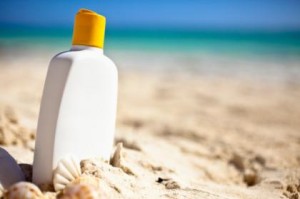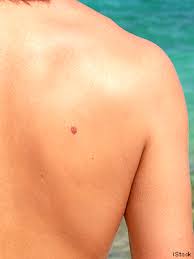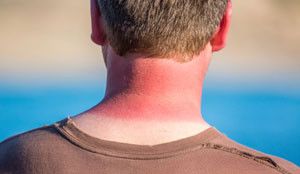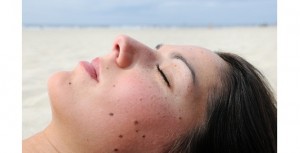 Most of us use sunscreen, but other than looking at price and the SPF levels, we know relatively little about what we are putting on our bodies. We use sunscreen to avoid a sunburn and to limit our exposure to the sun’s harmful rays.
Most of us use sunscreen, but other than looking at price and the SPF levels, we know relatively little about what we are putting on our bodies. We use sunscreen to avoid a sunburn and to limit our exposure to the sun’s harmful rays.
Here’s what you should know about UVA and UVB Rays:
UVA rays:
• Can pass through glass, such as a car window
• Are always present despite changes in altitude or weather, season and time of day
• Can penetrate deep into skin layers
• Totals 5% of the sun’s rays
UVB rays:
• Can’t pass through glass
• Can cause the skin to burn/tan
• Intensity of rays change with the weather conditions, altitude, season and time of day
• Totals 0.5% of the sun’s rays
Theoretically when applying sunscreen, the higher the sun protection factor – SPF – the more time you can spend out in the sun before suffering a sunburn. This is not true: at least for high-SPF sunscreens of SPF 50 and over. Many studies have found that people are misled by the claims on high SPF sunscreen bottles.
Most of us assume that we’ll get twice as much protection from SPF 100 sunscreen as from SPF 50. In reality, the extra protection is negligible and gives a false sense of security, which leads to longer stays stay in the sun, and overexposing ourselves to UVA and UVB rays.
Numerous studies show that sunscreen users apply the wrong amount of sunscreen. The average person uses about one-half the quantity of sunscreen that the manufacturers recommends. Applying too little sunscreen or reapplying it too infrequently diminishes protection against free radical formation which can lead to skin cancer.
How much sunscreen should you be using? You should use approximately two milligrams of sunscreen per square centimeter of skin. This means applying two tablespoons of sunscreen to the exposed areas of the face and body, and remembering that sunscreen needs to be reapplied every two hours.
High SPF products require higher concentrations of active chemicals than lower SPF sunscreens, and some of these ingredients may pose health risks when they penetrate the skin. Sunscreen formulas come in two forms, mineral and chemical.
Mineral sunscreens use zinc oxide and/or titanium dioxide.
Chemical sunscreen products typically include a combination of two to six active ingredients such as: oxybenzone, avobenzone, octisalate, octocrylene, homosalate and octinoxate.
The table below outlines human exposure and toxicity information for nine approved sunscreen chemicals.
| Chemical | EWG Hazard Score | Use in U.S. sunscreens | Skin Penetration | Hormone disruption | Skin Allergy | Other concerns | References |
| UV filters with higher toxicity concerns |
| Oxybenzone | 8 | Widespread | Detected in nearly every American; found in mother’s milk; 1-to-9% skin penetration in lab studies | Acts like estrogen in the body; alters sperm production in animals; associated with endometriosis in women | Relatively high rates of skin allergy | | Janjua 2004, Janjua 2008, Sarveiya 2004, Gonzalez 2006, Rodriguez 2006, Krause 2012 |
| Octinoxate (Octylmethoxycinnamate) | 6 | Widespread | Found in mothers’ milk; less than 1% skin penetration in human and laboratory studies | Hormone-like activity; reproductive system, thyroid and behavioral alterations in animal studies | Moderate rates of skin allergy | | Krause 2012, Sarveiya 2004, Rodriguez, 2006, Klinubol 2008 |
| UV filters with moderate toxicity concerns |
| Homosalate | 4 | Widespread | Found in mothers’ milk; skin penetration less than 1% in human and laboratory studies | Disrupts estrogen, androgen and progesterone | | Toxic breakdown products | Krause 2012, Sarveiya 2004, SCCNFP 2006 |
| Octisalate | 3 | Widespread; stabilizes avobenzone | Skin penetration in lab studies | | Rarely reported skin allergy | | Walters 1997, Shaw 2006 Singh 2007 |
| Octocrylene | 3 | Widespread | Found in mothers’ milk; skin penetration in lab studies | | Relatively high rates of skin allergy | | Krause 2012, Bryden 2006, Hayden 2005 |
| UV filters with lower toxicity concerns |
| Titanium Dioxide | 2 (topical use), 6 (powder or spray) | Widespread | No finding of skin penetration | No evidence of hormone disruption | None | Inhalation concerns | Gamer 2006, Nohynek 2007, Wu 2009, Sadrieh 2010, Takeda 2009, Shimizu 2009, Park 2009, IARC 2006b |
| Zinc Oxide | 2 (topical use), 4 (powder or spray) | Widespread; excellent UVA protection | Less than 0.01% skin penetration in human volunteers | No evidence of hormone disruption | None | Inhalation concerns | Gulson 2012, Sayes 2007, Nohynek 2007, SCCS 2012 |
| Avobenzone | 2 | Widespread; best UVA protection of chemical filters | Very limited skin penetration | No evidence of hormone disruption | Relatively high rates of skin allergy | | Klinubol 2008, Bryden 2006, Hayden 2005, Montenegro 2008 |
| Mexoryl SX | 2 | Uncommon; pending FDA approval; offers good, stable UVA protection | Less than 0.16% penetrated the skin of human volunteers | No evidence of hormone disruption | Skin allergy is rare | | Benech-Kieffer 2003, Fourtanier2008 |
|
Chemical sunscreens permeate the skin to some degree, and recently have been linked to tissue damage and potential hormone disruption.
“Laboratory studies of several sunscreen chemicals indicate that they may mimic hormones and disrupt the hormone system (Krause 2012, Schlumpf 2001, 2004, 2008).
Two European studies have detected sunscreen chemicals in mothers’ milk, indicating that the developing fetus and newborns may be exposed to these substances (Schlumpf 2008, Schlumpf 2010).”
Mineral Sunscreens are made with zinc oxide and titanium dioxide, and generally rate better than chemical sunscreens for toxicity.
Many sunscreens contain anti-inflammatory chemicals that can prevent skin from looking sunburned. This is a problem because if you can’t see your body turning red, you assume you are adequately protected from the sun’s rays…but that’s not true.
Consumers are being lulled into thinking that their sunscreen is providing more protection than it actually does, and the result is that they stay out longer in the sun and increase their risk of skin cancer and skin damage. So when it comes to sunscreens, do your homework!
 Article by: sunprotectionandproductsguide.com
Article by: sunprotectionandproductsguide.com





